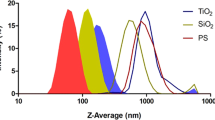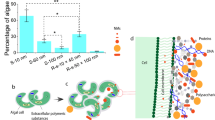Abstract
Previous studies have shown that engineered nanomaterials can be transferred from prey to predator, but the ecological impacts of this are mostly unknown. In particular, it is not known if these materials can be biomagnified—a process in which higher concentrations of materials accumulate in organisms higher up in the food chain. Here, we show that bare CdSe quantum dots that have accumulated in Pseudomonas aeruginosa bacteria can be transferred to and biomagnified in the Tetrahymena thermophila protozoa that prey on the bacteria. Cadmium concentrations in the protozoa predator were approximately five times higher than their bacterial prey. Quantum-dot-treated bacteria were differentially toxic to the protozoa, in that they inhibited their own digestion in the protozoan food vacuoles. Because the protozoa did not lyse, largely intact quantum dots remain available to higher trophic levels. The observed biomagnification from bacterial prey is significant because bacteria are at the base of environmental food webs. Our findings illustrate the potential for biomagnification as an ecological impact of nanomaterials.
This is a preview of subscription content, access via your institution
Access options
Subscribe to this journal
Receive 12 print issues and online access
$259.00 per year
only $21.58 per issue
Buy this article
- Purchase on Springer Link
- Instant access to full article PDF
Prices may be subject to local taxes which are calculated during checkout






Similar content being viewed by others
References
Barbeau, K., Moffett, J. W., Caron, D. A., Croot, P. L. & Erdner, D. L. Role of protozoan grazing in relieving iron limitation of phytoplankton. Nature 380, 61–64 (1996).
Clarholm, M. Interactions of bacteria, protozoa and plants leading to mineralization of soil-nitrogen. Soil Biol. Biochem. 17, 181–187 (1985).
Gude, H. Grazing by protozoa as selection factor for activated sludge bacteria. Microb. Ecol. 5, 225–237 (1979).
Ducklow, H. W. Production and fate of bacteria in the oceans. Bioscience 33, 494–501 (1983).
Vogel, C. & Fisher, N. S. Trophic transfer of Fe, Zn and Am from marine bacteria to a planktonic ciliate. Mar. Ecol. Prog. Ser. 384, 61–68 (2009).
Berninger, U. G., Finlay, B. J. & Kuuppoleinikki, P. Protozoan control of bacterial abundances in freshwater. Limnol. Oceanogr. 36, 139–147 (1991).
Sherr, E. B. & Sherr, B. F. Significance of predation by protists in aquatic microbial food webs. Anton. Leeuw. Int. J. G. 81, 293–308 (2002).
Pernthaler, J. Predation on prokaryotes in the water column and its ecological implications. Nat. Rev. Microbiol. 3, 537–546 (2005).
Whitman, W. B., Coleman, D. C. & Wiebe, W. J. Prokaryotes: the unseen majority. Proc. Natl Acad. Sci. USA 95, 6578–6583 (1998).
Schlesinger, W. H. Biogeochemistry: An Analysis of Global Change (Academic Press, 1997).
Hudson, M. J., Swackhamer, D. L. & Cotner, J. B. Effect of microbes on contaminant transfer in the Lake Superior food web. Environ. Sci. Technol. 39, 9500–9508 (2005).
Johnson, B. T. & Kennedy, J. O. Biomagnification of p,p'-DDT and methoxychlor by bacteria. Appl. Microbiol. 26, 66–71 (1973).
Mullen, M. D. et al. Bacterial sorption of heavy metals. Appl. Environ. Microbiol. 55, 3143–3149 (1989).
Madsen, E. L., Sinclair, J. L. & Ghiorse, W. C. In situ biodegradation: microbiological patterns in a contaminated aquifer. Science 252, 830–833 (1991).
Croteau, M. N., Luoma, S. N. & Stewart, A. R. Trophic transfer of metals along freshwater food webs: evidence of cadmium biomagnification in nature. Limnol. Oceanogr. 50, 1511–1519 (2005).
Luoma, S. N. & Rainbow, P. S. Metal Contamination in Aquatic Environments: Science and Lateral Management (Cambridge Univ. Press, 2008).
Klaine, S. J. et al. Nanomaterials in the environment: behavior, fate, bioavailability, and effects. Environ. Toxicol. Chem. 27, 1825–1851 (2008).
Stern, S. T. & McNeil, S. E. Nanotechnology safety concerns revisited. Toxicol. Sci. 101, 4–21 (2008).
Limbach, L. K. et al. Removal of oxide nanoparticles in a model wastewater treatment plant: influence of agglomeration and surfactants on clearing efficiency. Environ. Sci. Technol. 42, 5828–5833 (2008).
Thill, A. et al. Cytotoxicity of CeO2 nanoparticles for Escherichia coli. Physico-chemical insight of the cytotoxicity mechanism. Environ. Sci. Technol. 40, 6151–6156 (2006).
Priester, J. H. et al. Effects of soluble cadmium salts versus CdSe quantum dots on the growth of planktonic Pseudomonas aeruginosa. Environ. Sci. Technol. 43, 2589–2594 (2009).
Kaegi, R. et al. Synthetic TiO2 nanoparticle emission from exterior facades into the aquatic environment. Environ. Pollut. 156, 233–239 (2008).
Kiser, M. A. et al. Titanium nanomaterial removal and release from wastewater treatment plants. Environ. Sci. Technol. 43, 6757–6763 (2009).
Robichaud, C. O., Uyar, A. E., Darby, M. R., Zucker, L. G. & Wiesner, M. R. Estimates of upper bounds and trends in nano-TiO2 production as a basis for exposure assessment. Environ. Sci. Technol. 43, 4227–4233 (2009).
Bouldin, J. L. et al. Aqueous toxicity and food chain transfer of quantum dots in freshwater algae and Ceriodaphnia dubia. Environ. Toxicol. Chem. 27, 1958–1963 (2008).
Holbrook, R. D., Murphy, K. E., Morrow, J. B. & Cole, K. D. Trophic transfer of nanoparticles in a simplified invertebrate food web. Nature Nanotech. 3, 352–355 (2008).
Ghafari, P. et al. Impact of carbon nanotubes on the ingestion and digestion of bacteria by ciliated protozoa. Nature Nanotech. 3, 347–351 (2008).
Eccleston-Parry, J. D. & Leadbeater, B. S. C. A comparison of the growth kinetics of six marine heterotrophic nanoflagellates fed with one bacterial species. Mar. Ecol. Prog. Ser. 105, 167–177 (1994).
Stohs, S. J. & Bagchi, D. Oxidative mechanisms in the toxicity of metal ions. Free Radic. Biol. Med. 18, 321–336 (1995).
Rikans, L. E. & Yamano, T. Mechanisms of cadmium-mediated acute hepatotoxicity. J. Biochem. Mol. Toxicol. 14, 110–117 (2000).
Boenigk, J., Matz, C., Jurgens, K. & Arndt, H. The influence of preculture conditions and food quality on the ingestion and digestion process of three species of heterotrophic nanoflagellates. Microb. Ecol. 42, 168–176 (2001).
Corno, G. & Jurgens, K. Direct and indirect effects of protist predation on population size structure of a bacterial strain with high phenotypic plasticity. Appl. Environ. Microbiol. 72, 78–86 (2006).
Matz, C. et al. Impact of violacein-producing bacteria on survival and feeding of bacterivorous nanoflagellates. Appl. Environ. Microbiol. 70, 1593–1599 (2004).
Boenigk, J., Matz, C., Jurgens, K. & Arndt, H. Confusing selective feeding with differential digestion in bacterivorous nanoflagellates. J. Eukaryot. Microbiol. 48, 425–432 (2001).
Lewinski, N. A. et al. Quantification of water solubilized CdSe/ZnS quantum dots in Daphnia magna. Environ. Sci. Technol. 44, 1841–1846 (2010).
Lin, Y. W., Hsieh, M. M., Liu, C. P. & Chang, H. T. Photoassisted synthesis of CdSe and core–shell CdSe/CdS quantum dots. Langmuir 21, 728–734 (2005).
Nilsson, J. R. & Williams, N. E. in Biochemistiry and Physiology of Protozoa Vol. 2 (Academic Press, 1979).
Orias, E. & Pollock, N. A. Heat-sensitive development of phagocytotic organelle in a Tetrahymena mutant. Exp. Cell Res. 90, 345–356 (1975).
Fok, A. K., Lee, Y. & Allen, R. D. The correlation of digestive vacuole pH and size with the digestive cycle in Paramecium caudatum. J. Protozool. 29, 409–414 (1982).
Mahendra, S., Zhu, H. G., Colvin, V. L. & Alvarez, P. J. Quantum dot weathering results in microbial toxicity. Environ. Sci. Technol. 42, 9424–9430 (2008).
Eisen, J. A. et al. Macronuclear genome sequence of the ciliate Tetrahymena thermophila, a model eukaryote. PLoS Biol. 4, 1620–1642 (2006).
Nanney, D. L. & Simon, E. M. Tetrahmena thermophila (Academic Press, 1979).
Steinberger, R. E., Allen, A. R., Hansma, H. G. & Holden, P. A. Elongation correlates with nutrient deprivation in unsaturated Pseudomonas aeruginosa biofilms. Microb. Ecol. 43, 416–423 (2002).
Xie, L. T., Funk, D. H. & Buchwalter, D. B. Trophic transfer of Cd from natural periphyton to the grazing mayfly Centroptilum triangulifer in a life cycle test. Environ. Pollut. 158, 272–277 (2010).
Clarke, S., Mielke, R. E., Neal, A., Holden, P. & Nadeau, J. L. Bacterial and mineral elements in an Arctic biofilm: a correlative study using fluorescence and electron microscopy. Microsc. Microanal. 16, 153–165 (2010).
Acknowledgements
This research was primarily funded by US Environmental Protection Agency Science To Achieve Results (STAR) award no. R833323 (to P.A.H. and G.D.S.), and by the National Science Foundation and the Environmental Protection Agency under cooperative agreement no. DBI-0830117 (to P.A.H., G.N.C. and G.D.S.). Any opinions, findings and conclusions or recommendations expressed in this material are those of the author(s) and do not necessarily reflect the views of either the National Science Foundation or the Environmental Protection Agency. This work has not been subjected to Environmental Protection Agency review and no official endorsement should be inferred. Environmental scanning and scanning transmission electron microscopy were partly performed in the Micro-Environmental Imaging and Analysis Facility at University of California Santa Barbara (www.bren.ucsb.edu/facilities/MEIAF/) under National Science Foundation awards nos BES-9977772 and DBI-0216480. Transmission electron microscopy was partly performed in the University of California Santa Barbara Materials Research Laboratory Central Facilities supported by the Materials Research Science and Engineering Centers Program of the National Science Foundation under award no. DMR05-20415. The T. thermophila portion of the work was partially supported by grant no. R01-RR009231 from the National Center for Research Resources of the National Institutes of Health (to E.O.). The authors gratefully acknowledge critical comments on the manuscript by T. Klanjscek. Thanks also go to anonymous reviewers for valuable suggestions that led to significant improvement of the manuscript.
Author information
Authors and Affiliations
Contributions
P.A.H., J.H.P., R.W., E.O. and G.D.S. designed the experiment. P.K.S. and G.D.S. synthesized and provided the quantum dots. R.W. and J.H.P. executed the trophic transfer experiments. R.E.M. and S.K. performed the electron microscopy and EDS analyses. G.N.C. and S.J. determined protein carbonyl content. All authors contributed to the writing of the manuscript.
Corresponding author
Ethics declarations
Competing interests
The authors declare no competing financial interests.
Supplementary information
Supplementary information
Supplementary information (PDF 742 kb)
Rights and permissions
About this article
Cite this article
Werlin, R., Priester, J., Mielke, R. et al. Biomagnification of cadmium selenide quantum dots in a simple experimental microbial food chain. Nature Nanotech 6, 65–71 (2011). https://doi.org/10.1038/nnano.2010.251
Received:
Accepted:
Published:
Issue Date:
DOI: https://doi.org/10.1038/nnano.2010.251
This article is cited by
-
Material-engineered bioartificial microorganisms enabling efficient scavenging of waterborne viruses
Nature Communications (2023)
-
Environmental Carriers for Metal Nanoparticles: Transport, Fate, and Eco-risks
Reviews of Environmental Contamination and Toxicology (2023)
-
The Toxic Effects of Cu and CuO Nanoparticles on Euplotes aediculatus
Microbial Ecology (2023)
-
An analytical workflow for dynamic characterization and quantification of metal-bearing nanomaterials in biological matrices
Nature Protocols (2022)
-
Colloidal stability and aggregation kinetics of nanocrystal CdSe/ZnS quantum dots in aqueous systems: Effects of ionic strength, electrolyte type, and natural organic matter
SN Applied Sciences (2022)



